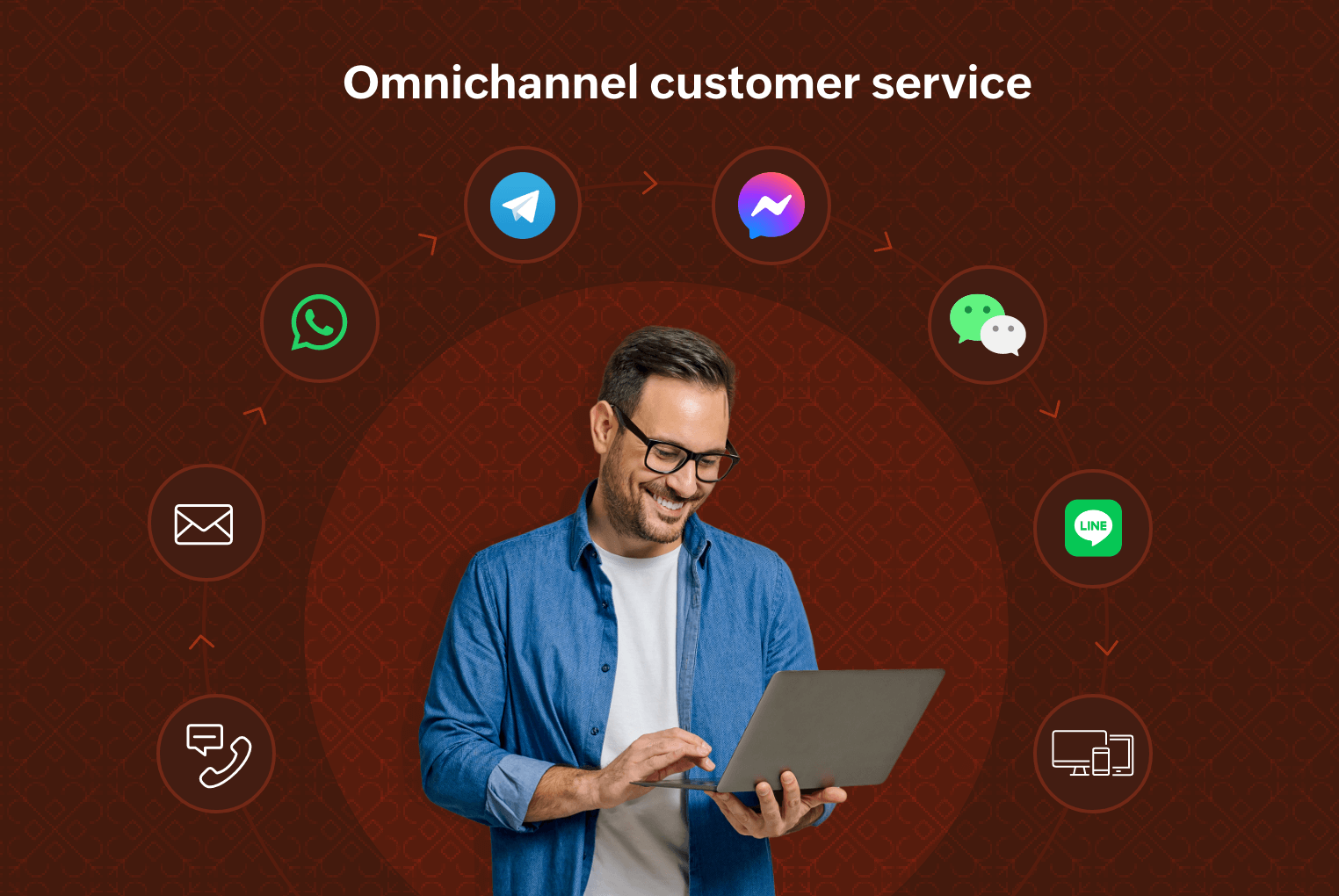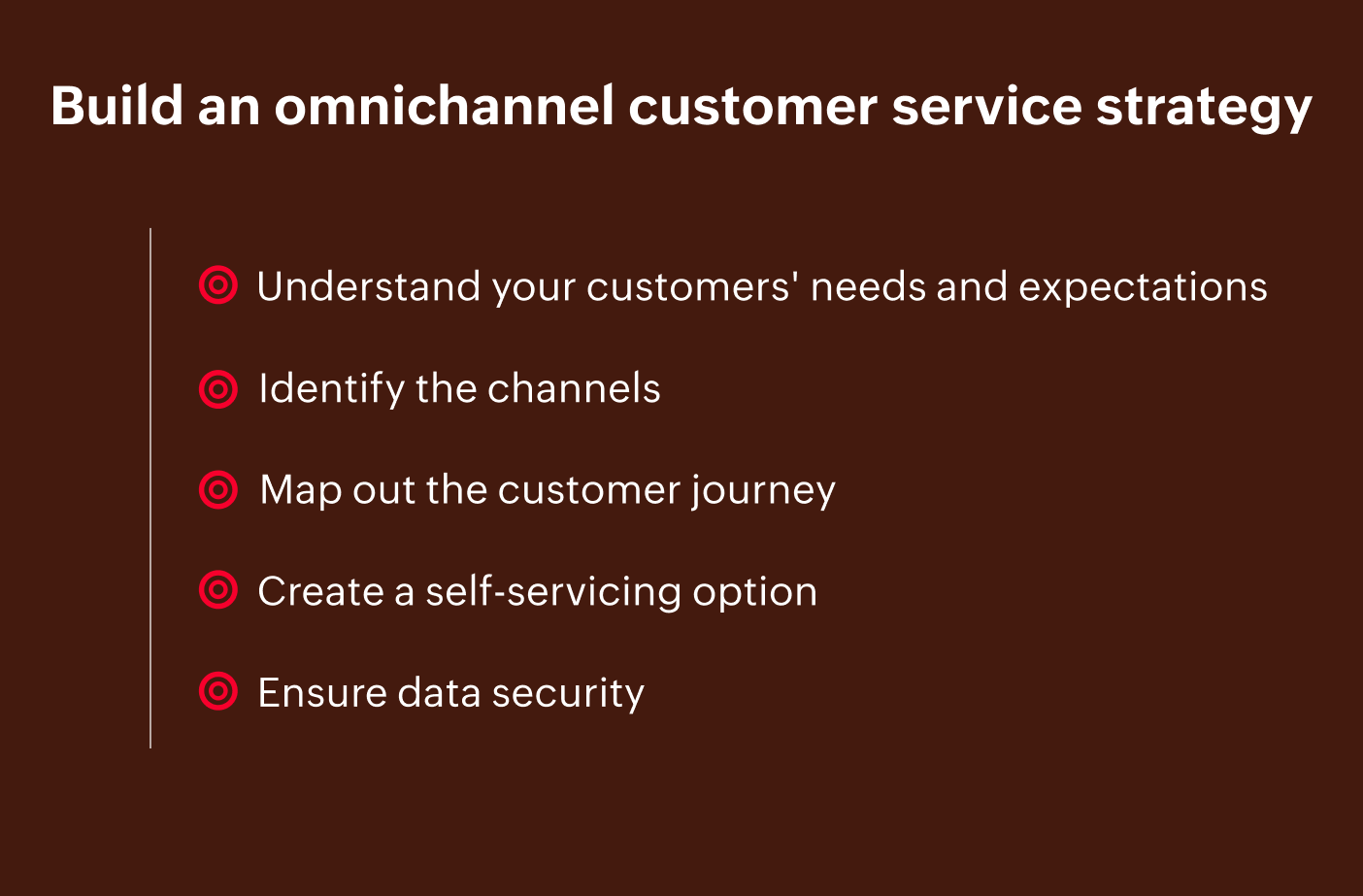
It's not just the channels and devices that make it omnichannel customer service. What truly defines it is the provision to integrate them so that the conversations can be moved seamlessly from one channel to another or one device to another without customers repeating themselves everywhere to get a resolution.
Omnichannel customer service is built so customers aren't restricted to fewer channels or specific devices. They can ask for support from their preferred channels/devices, and the businesses will be able to provide the requested information. But if customers prefer to switch channels/devices, businesses can continue the conversation without losing any context.
Omnichannel vs. multichannel customer service
- Omnichannel customer serviceMultichannel customer service
- Omnichannel service ensures smooth, streamlined, and uninterrupted conversations, addressals of issues, and resolutions no matter what happens.Multichannel, on the other hand, will have a presence on multiple channels to ease customer pain, but communication unification is not possible as everything will be disjointed.
- The significance of omnichannel customer service is that all the channels and devices will be integrated, which helps provide uninterrupted customer service.Customers can contact customer service via all available channels/devices in multichannel. Because they aren't integrated, shifting the conversation from one channel/device to another is impossible.
- Unifying customer communication data achieves omnichannel service. It helps businesses get an overview of the customer's journey across channels and platforms.Because unification is not happening, multichannel businesses won't be able to see customer data in one place, leading to a fragmented experience.
Why is it important to provide omnichannel customer service?
Even before online culture became popular, other choices were available to customers besides brick-and-mortar. People were buying things by and interacting with businesses via mail or phone.
The provision to buy and get help online took this to the next level, bringing multiple options. It's also opened up a whole new range of customer touchpoints, and businesses have to cover them all if they want to satisfy their customers.
Now channels aren't restricted to just mail/phone. We have SMS, email, video calls, and social network platforms. The devices aren't just restricted to landlines but advanced mobile phones, desktops, laptops, tablets, and the like.
As the role of customer service has grown beyond what it used to be and has become a distinguishable factor that customers look at when they buy, businesses don't have the luxury of picking one channel/device to engage with them. We've come to the place where customers are willing to compromise on some features if they get good support.
Customers also have their preferred mode of communication. If asked to change it, they'd instead consider moving to a newer business that offers customer service via their communication channel.
So, it's become not just important but necessary for businesses to be in all the places to provide customer service.
Benefits of omnichannel customer service
Providing omnichannel customer service offers a plethora of benefits to customers, which in turn benefits businesses a lot. Let's look at a few.
For customers
1. Convenience
Having an omnichannel customer service option itself tells your customers and prospects alike that you're available when they're needed via any medium. It gives them the confidence to get into business with you. When they want to reach out to your support, it provides them with a lot of flexibility as it's a convenience for them not to worry about which channel to use and which would provide them with the instant support they require.
Because of the availability to switch between channels and devices—let's say the customers are reaching out on Instagram via mobile, but the resolution requires you to do a remote access/screen share session—your support team can seamlessly take the conversation to desktops/laptops via the web to proceed.
The customers don't have to go through the long ordeal of explaining their issues. They can simply switch mediums and devices for instant resolution. Omnichannel customer service becomes convenient as it requires fewer actions from the customers' end, but they get instant support.
2. Instant response and faster resolution
Omnichannel customer service is about more than just convenience for your customers. If they don't get instant response and resolution, convenience wouldn't be a distinguishable factor in choosing your business.
With omnichannel, their chance of getting an instant response is high as the channels and devices are integrated. It also increases their chance of getting faster resolution, which adds value to the convenience factor and could be a game changer for your customers.
3. Better customer engagement experience
By making the customer service process convenient for the customers to reach out and providing instant resolution and faster support with omnichannel customer service, it helps businesses provide a uniform engagement at various customer touchpoints, which in turn helps deliver a better customer experience.
Though reaching out to the customer service teams isn't a joyous process, enhancing the engagement experience customers get from the process makes it pleasurable and memorable, or at least doesn't make them detest it.
4. Increases customer loyalty and retention
Customers get all these benefits because when businesses provide omnichannel customer service, it helps them develop an affinity with your business and the service you offer. The affinity turns into loyalty, and they become your spokesperson in everything you do. Moving away from just being your customers, they become your loyalists, which in turn makes them stay with you for a long time, increasing your retention and customer lifetime value.
For businesses
1. Streamlined customer service and reduced operating cost
Omnichannel helps businesses unify all their customer data and streamline how they provide service. It gives them a complete overview of their support operations, removes roadblocks, and gives insights into what else they can do. Streamlining also helps lower their support operating costs over the years.
2. Multiple options to reach customers
Omnichannel customer service helps businesses deliver instant responses and faster resolutions, making the engagement experience convenient for customers and increasing their loyalty. It also gives businesses the advantage of having multiple options to reach out to customers when needed.
As business communication is moving away from email/phone communication, it opens up options for businesses to communicate via the channels the customers prefer.
Omnichannel customer service: Use cases and examples
Whatever domain you're in, whomever you cater to, having an omnichannel service would not just elevate your customers' engagement experience but also help you earn their trust and loyalty for a long time. Still think it's not for you? Let us see some examples of how omnichannel presence is changing the service scene.
You're a B2B business, and your customers' preferred mode of communication is email. Customer service cannot be taken lightly, and specifically for B2Bs, it's crucial as your customers are answerable to their customers.
When customers face any issues and mail your business, if it can be instantly resolved, an email reply will suffice. However, if something needs to be analyzed on the customers' end, it cannot be done via email.
The customer instantly initiates a chat. Because it's omnichannel, the email and chat conversations are synced up, so the business can instantly initiate a screen sharing /remote access session to check the issue and provide a resolution.
Let's take B2C, for instance. More than traditional communication channels, customers, especially B2C target audiences, prefer SM/IM channels such as WhatsApp, Instagram, Telegram, and more. Customers don't have to hop to a specific channel/platform to reach out. They can initiate their conversation on Instagram while browsing and carry on the conversation in WhatsApp or any of their preferred communication channels.
How to build an omnichannel customer service strategy
As beneficial as it sounds and as it is, here are some tips on how businesses should plan their omnichannel customer service strategy.

Understand your customers' needs and expectations
Businesses should look into their customers' needs and expectations as part of their customer engagement strategy. Having omnichannel customer service for the sake of providing isn't going to benefit customers. So, looking into their current state of customer service and understanding if their customers are reaching out from multiple channels/devices can help them realize if they need omnichannel customer service.
Identify the channels
After figuring out if they need such a solution, businesses should identify the channels they want to include as a part of their omnichannel network. Based on how they operate and the kind of services they provide, they can opt for messaging channels that sit well with their operational strategy. For example, if they don't have customers from Japan, adding Line to their customer service network wouldn't add value as there are no users.
Map out the customer journey
Customers' journeys with businesses vary based on multiple factors. It's imperative to identify how they move across the map and find the touchpoints where they need help from your support teams.
Mapping out the customer journey and identifying the touchpoints helps you determine how and when to deploy your omnichannel network for assistance, and it also helps make sure you're there whenever and whenever you're needed.
Create a self-servicing option
Along with omnichannel customer service, to provide instant response and faster resolution, it's crucial to have self-servicing tools integrated with your support process. It could be in the form of articles, resources, and knowledge bases that the customers can go through to resolve their queries. Or it could be an FAQ chatbot that'd help find precisely what the customers are looking for.
Ensure data security
Since multiple channels and devices are integrated into a single network to provide omnichannel customer service, businesses have the onus to ensure the data will be secured and doesn't threaten their customers. So, it's crucial to have data security in your omnichannel customer service strategy.
If the process to have omnichannel customer service feels overwhelming, you can simply get the best tool that does the job for you.
Zoho SalesIQ, the best multichannel customer service platform for your business
Zoho SalesIQ, the Engagement Intelligence, is an all-in-one platform for your marketing, sales, and customer service needs.
With its direct integration with Zoho Desk and Zendesk , built-in audio call, and integration with all the major social channels such as WhatsApp, Instagram, Facebook Messenger, Telegram, WeChat, and Line, it's the only platform you need to provide the best multichannel experience to your customers.
Want to see it in action? Sign up now for free—no credit card is needed.
Related resources
Here are some blogs to help you learn about the other facets of omnichannel and multichannel.











